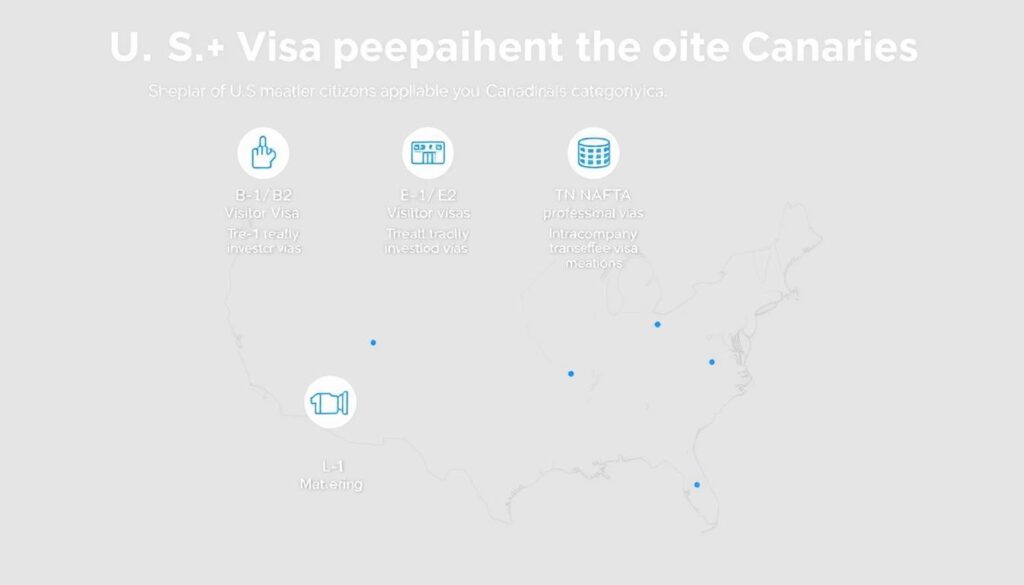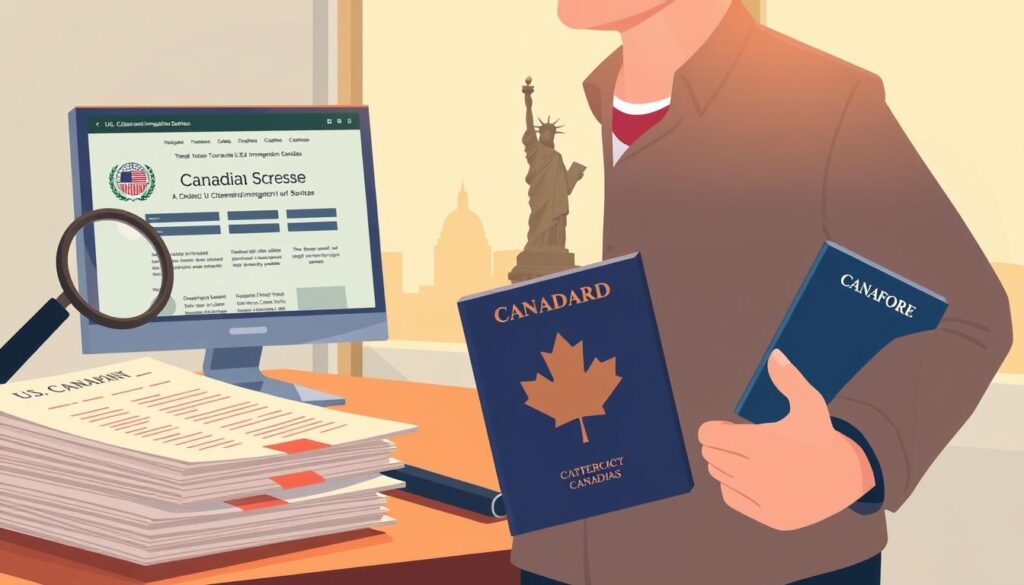Over 10,000 Canadian citizens relocate to the United States annually, drawn by career prospects, lifestyle changes, or family ties. Navigating this transition requires clarity—especially when securing the right visa and managing finances.
The Canada Visa Portal simplifies your journey. Whether exploring work permits, dual citizenship, or cost-effective CAD-USD transfers (like MTFX), this hub streamlines every step.
Key considerations include visa categories, tax planning, and cultural adjustments. With the right preparation, crossing the border becomes an exciting new chapter.
Introduction
With over 1.2 million Canadians already living in the US, relocation is a well-trodden path. Cities like Seattle and Miami boast thriving expat communities, offering familiar comforts while you adjust to your new home.
Yet crossing the border involves more than packing boxes. Navigating two tax systems and complex immigration laws requires expert guidance. The Canada Visa Portal simplifies this by clarifying visa requirements and connecting you with cross-border financial advisors.
Common motivations include career growth, warmer climates, or top-tier education. But beware: TFSA and RRSP accounts may face unexpected tax implications once you’re a US resident.
Whether you’re drawn by opportunity or lifestyle, preparation is key. Understanding these steps early ensures a smoother transition between countries.
Understanding the Basics of Moving to the USA from Canada
Relocating south of the border involves more than geography—it’s a legal and financial shift. Canadian citizens must prepare for stark contrasts in healthcare, taxation, and immigration rules. Here’s what you need to know before packing your bags.

Healthcare systems diverge sharply. Canada’s universal coverage is replaced by employer-based plans or private insurance in the US. Budget for premiums, deductibles, and out-of-pocket costs—especially during the gap before your US coverage begins.
Taxes grow more complex. The IRS requires FATCA compliance, meaning you’ll report global assets. Meanwhile, Canada’s deemed disposition rules treat most assets as sold upon exit, triggering capital gains taxes. Plan with a cross-border accountant.
- USCIS visa categories: TN visas suit professionals, while H-1Bs require employer sponsorship. L-1 transfers apply to intracompany moves.
- Credit history: Your Canadian score won’t transfer. Start with secured credit cards or American Express’s Global Transfer program.
- Dual filings: The CRA and IRS both demand returns. Tax treaties may reduce double taxation.
Each step in the process demands research. Whether adapting to US healthcare or navigating visa paperwork, early preparation prevents costly oversights.
How Do I Move to the USA from Canada: Key Steps
Planning your relocation requires a clear roadmap to avoid costly mistakes. Start preparations at least 24 months ahead to navigate tax implications and visa processing times smoothly.
Follow these critical steps to ensure compliance and minimize disruptions:
- Financial preparation: Consult a cross-border accountant to address deemed disposition taxes and IRS filing requirements. Update your departure date with Canadian authorities to trigger proper tax residency changes.
- Document assembly: Gather your I-130 or I-140 form (for family/employment petitions), passport with 6+ months validity, and FMV documentation for assets. If sponsored by an employer, keep your job offer letter accessible.
- Moving logistics: Services like U-Pack require advance booking during peak seasons. Research state-specific rules for importing vehicles and household goods duty-free.
Don’t overlook post-arrival essentials. Most states mandate driver’s license conversion within 30-90 days—prepare for written tests even with a valid Canadian license.
For families, initiate school enrollment early. US districts often require vaccination records, prior transcripts, and proof of residency. Some states impose additional health screenings for incoming students.
Types of Visas for Canadians Moving to the USA
Canadian citizens have multiple visa pathways when relocating south. The US system divides these into two broad categories: immigrant and nonimmigrant. Each serves distinct purposes, from permanent residency to temporary employment.

Immigrant Visas
EB-5 investor visas require an $800,000 minimum investment (2023 update) in a US commercial enterprise. This immigrant visa grants conditional green cards, transitioning to permanent status after job creation verification.
Family-sponsored options (I-130 petitions) hinge on relationships with US citizens or permanent residents. Processing times vary—spouses and minor children typically receive priority.
Nonimmigrant Visas
For professionals, TN visas under CUSMA offer streamlined approval for listed occupations like engineers or accountants. Unlike H-1Bs, they avoid annual quotas but require employer letters detailing role specifics.
- H-1B: Subject to April lottery draws; STEM roles may qualify for 3-year OPT extensions.
- L-1: Ideal for intracompany transfers, requiring 1+ year with a linked foreign employer.
- Diversity Visa Lottery: Canadians are eligible, though selection odds remain low (≈1%).
F-1 student visas permit post-graduation work via OPT, extendable for STEM degrees. Always confirm application windows—H-1B filings, for instance, open only in early April.
Applying for a US Work Visa as a Canadian
Canadian professionals have distinct advantages when applying for American work visas. The US offers tailored options like TN, H-1B, and L-1 visas, each with specific requirements and processing times.
TN visas under USMCA cover 60+ professions, from engineers to accountants. Unlike H-1Bs, they avoid annual caps but demand a detailed employer letter outlining your role. Approval often occurs at the border.
Key Visa Comparison
| Visa Type | Eligibility | Processing Time | Key Notes |
|---|---|---|---|
| TN (USMCA) | Listed professions | Same-day | No lottery; renewable indefinitely |
| H-1B | Specialty occupations | 3-6 months | 65,000 annual cap; lottery system |
| L-1 | Intracompany transfers | 1-4 months | Requires 1+ year with linked employer |
For H-1Bs, the April lottery sees fierce competition. Premium processing ($2,500) speeds decisions to 15 days. Ensure your employer files a Labor Condition Application (LCA) proving fair wages.
L-1 visas suit executives transferring within multinational companies. Prepare organizational charts and proof of employment history. Portability rules let you switch jobs if your new role matches the visa’s terms.
Canadian citizens should start early—gather diplomas, job offers, and tax records. Consult an immigration lawyer to navigate nuances like state-specific licensing for regulated professions.
Student Visas: Studying in the USA
Pursuing education in the US opens doors for Canadian students, but visa rules require careful navigation. The F-1 student visa is the most common pathway, granting access to accredited institutions. Start by paying the SEVIS fee—a mandatory $350 charge to register in the Student and Exchange Visitor Information System.

Work authorization comes in two forms: CPT (Curricular Practical Training) and OPT (Optional Practical Training). CPT allows employment during your program, while OPT offers 12 months post-graduation. STEM graduates enjoy a 36-month extension—a major perk for tech and engineering students.
Financial planning is critical. Canadian student loans may not transfer seamlessly; check with your provincial lender. Private loans often require a US co-signer, adding complexity.
- Health insurance: Most universities mandate coverage meeting US standards. Verify if your Canadian plan qualifies or budget for campus policies.
- Work limits: On-campus jobs cap at 20 hours/week during terms. Off-campus roles require prior authorization under CPT/OPT rules.
“OPT extensions for STEM fields reflect the US push to retain global talent—leveraging this can accelerate your career.”
Cultural exchanges enrich the experience, but paperwork dominates early months. Track deadlines for visa renewals and employment applications to maintain status.
Family-Based Immigration Options
US immigration policies prioritize keeping families together through specific visa categories. Canadian applicants often qualify as immediate relatives or under family preference tiers. Spouses, parents, and unmarried children under 21 of US citizenship holders get priority.
Marriage-based cases receive conditional Green Cards valid for two years. To convert these to permanent status, couples must jointly file Form I-751 within 90 days of expiration. Evidence of bona fide marriage—joint leases, photos, or financial ties—strengthens applications.
The Affidavit of Support (I-864) requires sponsors to meet income thresholds—125% of the federal poverty level. Self-employed petitioners submit IRS transcripts, while joint sponsors help if primary incomes fall short.
- K-1 fiancé visas: Process in 6–9 months; require marriage within 90 days of entry.
- Child Status Protection Act: Freezes beneficiaries’ ages at petition filing to prevent “aging out.”
- VAWA protections: Allow abused spouses or children of US residents to self-petition without the abuser’s knowledge.
“Immediate relative visas have no annual caps, making them faster than preference categories like siblings of citizens (F4), which face decade-long backlogs.”
Consult an immigration lawyer to navigate complex timelines. Missing deadlines—like the 30-day window for adjusting K-1 status—can jeopardize eligibility.
The Green Card Process for Canadians

For Canadian applicants, Green Card approval hinges on meeting specific eligibility criteria. The US limits each country to 7% of total annual issuances, making early preparation critical. Whether through employment, family ties, or the Diversity Visa Lottery, understanding the process avoids delays.
Two primary pathways exist:
- Adjustment of Status: File Form I-485 while legally residing in the US (e.g., on a work visa).
- Consular Processing: Apply through a US embassy if outside the country, requiring an interview.
Employment-based options (EB-1 to EB-5) prioritize skills and investments. EB-1 visas suit executives or researchers, while EB-5 requires $800,000+ in qualifying projects. Each category has unique wait times—EB-2/EB-3 often face multi-year backlogs.
| Category | Eligibility | Processing Time |
|---|---|---|
| EB-1 | Extraordinary ability or multinational executives | 6–12 months |
| EB-2 | Advanced degrees or exceptional skills | 2–3 years |
| EB-3 | Skilled workers/professionals | 3–5 years |
| EB-5 | Investors creating jobs | 18–36 months |
Medical exams (Form I-693) and financial stability checks are mandatory. The public charge rule assesses whether applicants might rely on government aid. Prepare tax returns, employment letters, and asset proofs.
Conditional Green Cards apply to marriage-based cases (valid for 2 years), requiring joint petitions to remove conditions. Permanent cards offer stability but mandate renewals every 10 years. Dual citizenship is permitted, though tax filings grow complex.
“EB-1 applicants often bypass labor certification, accelerating approval—ideal for academics or athletes with documented achievements.”
Canadians selected in the Diversity Visa Lottery must act swiftly: visas expire if unused by fiscal year-end. Consult an immigration lawyer to navigate evolving policies affecting residents.
Financial Planning for Your Move
Smart financial planning eases the transition when relocating south. Budgeting for US expenses while managing Canadian assets requires tailored strategies. From closing TFSAs to optimizing currency exchanges, each step impacts your long-term stability.
Cost of Living in the USA
US expenses vary sharply by state. Property taxes in Texas offset its lack of income tax, while California combines high taxes with steep real estate prices. Research regional differences to avoid budget shortfalls.
| State | Income Tax | Avg. Property Tax |
|---|---|---|
| Texas | 0% | 1.8% |
| California | 13.3% | 0.7% |
| Florida | 0% | 0.9% |
Factor in hidden costs like homeowners’ association fees or parking permits. Urban areas often demand higher salaries to maintain Canadian living standards.
Managing Cross-Border Finances
Navigating two financial systems starts with closing your TFSA—the IRS taxes its growth. Retain RRSPs but note 401(k) contribution limits may differ from Canadian plans.
- Currency exchange: Use Norbert’s Gambit for large CAD-USD conversions to minimize fees.
- Brokerage accounts: Interactive Brokers suits active traders; Wise offers lower fees for routine transfers.
- Mortgages: US lenders often disregard Canadian credit history. Prepare for larger down payments.
“Cross-border moves demand proactive tax planning—especially for investments. A dual-licensed advisor bridges gaps between CRA and IRS rules.”
Update banks and insurers about your move. Some Canadian accounts may face restrictions once you’re a US resident.
Tax Considerations for Canadians in the USA
Navigating tax obligations between two nations demands careful planning. The Canada-US Tax Treaty helps avoid double taxation, but rules vary by income type and residency status. Article XXIV credits let you offset taxes paid in one country against liabilities in the other.

- Form 8833: Disclose treaty positions to the IRS, especially for retirement accounts or rental income.
- PFIC rules: Canadian mutual funds often trigger complex reporting. Consider switching to US-compliant investments.
- FTC vs. FEIE: Foreign Tax Credits (FTC) suit high earners; Foreign Earned Income Exclusion (FEIE) benefits those below $112,000/year.
State taxes add another layer. Texas and Florida lack income tax, while California taxes global income for residents. Track physical presence thresholds—183+ days typically establishes residency.
Asset reporting is critical. File FBAR (FinCEN 114) for foreign accounts exceeding $10,000. Form 8938 applies if total assets surpass $200,000 (single) or $400,000 (joint).
“Missing FBAR deadlines risks penalties up to 50% of account balances—early disclosure programs mitigate fines.”
Dual-status filers (part-year citizens) split income between countries. Consult a cross-border accountant to optimize withholdings and deductions.
Finding Housing in the USA
From FICO scores to HOA fees, US housing comes with unique considerations for newcomers. Whether renting or buying, understanding local markets saves time and money.
Start by comparing listings on Zillow (detailed pricing trends) and Realtor.com (MLS-backed data). Major cities like NY or Austin have vastly different cost structures—research median prices per square foot.
Key Steps for Homebuyers
- FICO scores: Build credit via secured cards or becoming an authorized user. Scores below 620 may disqualify you from conventional mortgages.
- Insurance: HO-3 policies cover single-family homes, while HO-6 suits condos (including liability).
- 1031 exchanges: Canadian investors can defer capital gains by reinvesting in US real estate within 180 days.
| State | Avg. HOA Fee (Monthly) | Renters’ Rights |
|---|---|---|
| New York | $600 | Strict eviction protections |
| Florida | $400 | Landlords can withhold deposits for damage |
| Texas | $250 | No rent control |
Renters should review lease terms carefully. States like California require 30-day notices for rent hikes, while Florida allows landlords to charge non-refundable fees.
“HOAs often enforce strict rules—review covenants before buying to avoid fines for exterior modifications.”
Factor in the cost of utilities, which vary by region. Southern states may have higher cooling bills, while northeastern winters spike heating expenses.
Healthcare in the USA: What Canadians Need to Know
Healthcare differences between Canada and the US demand careful evaluation. Unlike Canada’s universal system, American healthcare relies on private insurance, employer plans, or government programs. Prepare for enrollment deadlines, varying costs, and coverage gaps.
Canadian citizens must enroll during the ACA marketplace’s annual window (November–January). Special enrollment periods apply for life events like job loss. Missing deadlines may leave you uninsured.
Plan Types Compared
| Plan | Key Features | Best For |
|---|---|---|
| HDHP | Lower premiums; high deductibles | Healthy individuals |
| PPO | Flexible networks; higher cost | Families needing specialists |
- COBRA: Extends employer coverage for 18 months post-job loss. Expect premiums 2–3x higher.
- Medicare: Green Card holders qualify after 5 years. Part B covers outpatient care ($164.90/month in 2023).
- Prescriptions: Importing Canadian drugs is illegal without FDA approval. Check formulary lists for covered medications.
“Medical underwriting for private plans may exclude pre-existing conditions—ACA-compliant plans avoid this but have stricter enrollment periods.”
Canadian citizens should budget for out-of-pocket maximums ($9,100/year for individuals). Emergency care remains accessible but balance billing can surprise unwary patients.
Moving Your Belongings Across the Border
Customs regulations differ significantly between Canada and the US—know the rules before packing. Proper documents prevent holdups at checkpoints. Start with Form 3299, which declares duty-free entry for personal items owned over a year.
Some items face strict bans. Firearms require ATF permits, while plants need USDA phytosanitary certificates. Even common groceries like citrus fruits may be confiscated.
Prohibited Items
| Category | Restrictions |
|---|---|
| Firearms | ATF Form 6 required |
| Plants/Soil | USDA inspection mandatory |
| Alcohol | Limited to 1L per adult |
Pets need CDC approval, especially dogs from rabies-risk countries. Vaccination records must include microchip numbers. Airlines often impose additional crate rules.
- High-value items: Jewelry or art exceeding $10,000 needs appraisals.
- Insurance: Allied covers door-to-door, while North American offers storage riders.
“U-Pack’s customs clearance takes 48+ hours—factor this into your moving timeline.”
Label boxes clearly with contents and values. Photograph high-ticket items pre-move for damage claims. With planning, crossing the border stays smooth.
Cultural Adaptation: Life in the USA
Three cities stand out as welcoming hubs for Canadians starting their American journey. Seattle, Austin, and Raleigh offer strong expat communities where you’ll find Tim Hortons and hockey bars alongside local culture.
Social customs differ in your new country. Tipping norms range from 15-25% for services—higher than Canada’s standard 15%. Servers rely on tips as base wages often fall below minimum wage.
| Service | Expected Tip |
|---|---|
| Restaurants | 18-22% |
| Rideshares | 15-20% |
| Hairstylists | 20%+ |
Workplace conversations require more caution. Avoid heated topics like healthcare policies or gun laws until you grasp office dynamics. Many companies encourage neutral discussions about sports or weather instead.
Measurement systems will test your mental math. Gas pumps show gallons, thermostats use Fahrenheit, and road signs display miles. Keep a conversion app handy until imperial units feel natural.
- Education perceptions: Community colleges hold more prestige than in Canada, often partnering with universities for degree transfers.
- Sports culture: NFL and NBA games dominate social calendars. Learning team rivalries helps you bond with neighbors.
“Canadians often report the friendliest transitions in Austin—its music scene and outdoor lifestyle feel familiar yet distinctly Texan.”
With this cultural guide, you’ll soon feel at home in your chosen city. Embrace local traditions while keeping poutine recipes handy for nostalgic moments.
Setting Up Your New Life in the USA
Establishing roots in a new country requires mastering practical essentials beyond visas and paperwork. Your first month should focus on securing identification, financial access, and essential services to make the US feel like home.
Start with your Social Security Number (SSN). Complete Form SS-5 at a local office with your passport and I-94 arrival record. Processing takes 2-4 weeks—request a receipt for interim use when opening bank accounts.
State IDs and driver’s licenses follow different rules. Arizona accepts Canadian licenses for 30 days, while Texas requires immediate conversion. Bring:
- Proof of residency (lease or utility bill)
- Original birth certificate
- SSN confirmation
Banking involves ChexSystems verification—a US credit reporting agency. Avoid rejections by:
- Starting with Chase or TD Bank (familiar with Canadian clients)
- Using secured credit cards to build history
- Monitoring your ChexSystems report for errors
“Canadian newcomers often overlook voter registration. Most states allow non-citizen residents to vote in local elections—check county websites for eligibility.”
For mail, virtual services like Traveling Mailbox provide street addresses accepted by DMVs and banks. Physical PO boxes cost $20-$80/month but limit package acceptance.
Each step in this process brings you closer to feeling settled. With documents secured and systems in place, your American home becomes fully functional.
Common Challenges and How to Overcome Them
IRS audits affect 40% of expats—a startling statistic highlighting common challenges. Canadian families and professionals face unique hurdles when settling in the US. Proactive planning minimizes disruptions.
Visa pitfalls top the list. Dual intent applications require careful wording—mentioning future Green Card interest may deny TN visa approval. Always separate temporary work intent from long-term plans.
Canadian pensions trigger unexpected withholding taxes. The IRS imposes 15-30% on RRSP/RRIF withdrawals unless you file Form W-8BEN. Cross-border accountants help reduce this through treaty provisions.
- Estate conflicts: Wills may need dual validation. US probate courts often disregard Canadian documents.
- Child custody: Jurisdiction disputes arise when parents live in different countries. Always update separation agreements.
- Professional licences: Nursing or engineering credentials often require equivalency exams. Start the process 6+ months early.
“State-specific rules govern most licensing boards. California’s nursing requirements differ sharply from Texas—research before relocating.”
These types of obstacles have solutions. For IRS audits, maintain organized records of foreign income and tax credits. Seek tips from expat communities—Facebook groups like “Canadians in Texas” share valuable insights.
With preparation, each challenge becomes manageable. Document everything and consult specialists early in your transition.
Conclusion
Crossing the border marks the start of an exciting journey, but preparation ensures success. The Canada Visa Portal simplifies every step, from visa applications to financial transitions. Partnering with experts like SWAN Wealth streamlines cross-border planning.
Follow a 12-month checklist for a smooth move. Secure USCIS-certified translators for legal documents. Research state rules for importing vehicles or pets. Annual reviews of tax filings in both countries prevent surprises.
Liquidate TFSAs early—the IRS taxes their growth. With this guide, you’re equipped to thrive in your new chapter. The Canada Visa Portal remains your trusted resource for updates.



